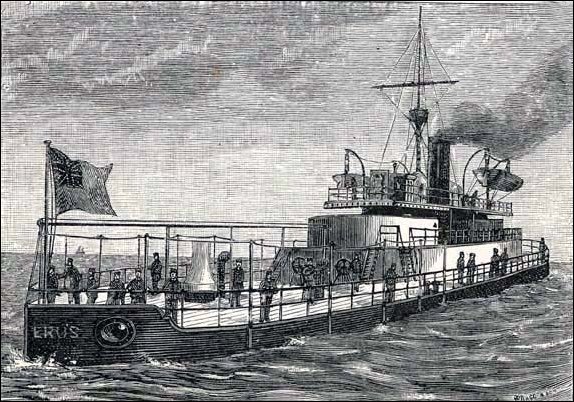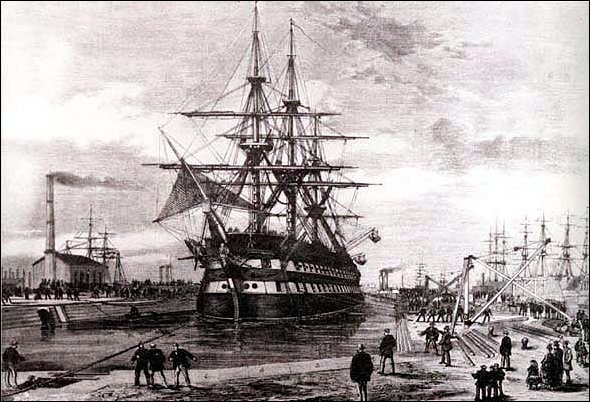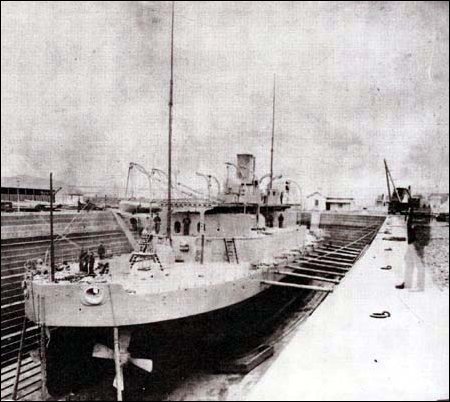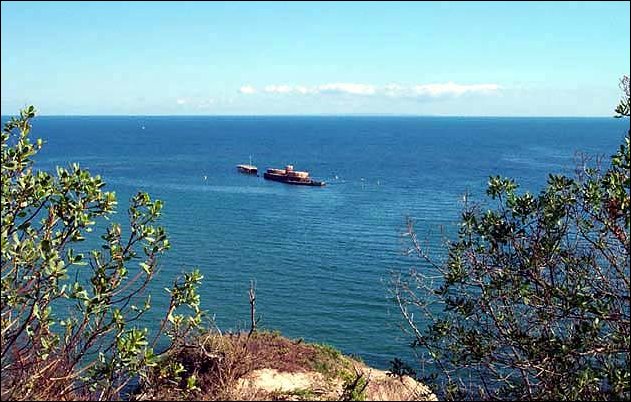The Cerberus

HMVS Cerberus part of Victoria’s colonial navy. C1888.
If you had been standing on the red sandstone cliffs at Black Rock (Melbourne) early on that Spring day of September, 1926, and had gazed across the blue waters of Port Phillip towards Williamstown, you would have seen an occurrence of considerable historical interest.
Towing a massive warship of strange design (likened by some to ‘an elongated gasometer’) were three tugs the ‘Agnes’, the ‘Minah’ and the ‘Plover’. With the help of a strong north wind, we would have seen them moving the ironclad monitor, ‘Cerberus’, from Williamstown where it had been dismantled, to its last resting place at Half-Moon Bay, Sandringham.
After the Crimean War (1854-57) there had been an uneasy peace between Russia and Britain, and this state of affairs was reflected in the nervousness of the six Australian colonies which relied for their very existence on the protection of the British Navy, but unfortunately these ships were very often many thousands of miles from the Australian ports.
The citizens of Victoria, believing that the weak forts at Williamstown, Sandridge (Port Melbourne) and Queenscliff were of little value, were convinced that their colony was sadly exposed to an attack by any marauding force cruising off our shores.
This was the public feeling in the days before Federation in 1901, but after Victoria had attained the status of a self-governing colony (1st July, 1851). Each Australian colony in those early days had only two or three old, weak war vessels to protect them, and each colony acted quite independently of the others.
The colony of Victoria at that time had in its service the first Australian warship, the beautiful seven-gun sloop ‘Victoria’ (1864) and also the obsolete ‘Nelson’ (1866), but these were far from being strong enough to hold off an attack.

HMVS Nelson in the Alfred Graving dock at Williamstown.
The colonists therefore decided in 1867 to purchase a powerful modern turret-ship which would remain as a guard ship in the Bay. It was to cost £125,000, of which Britain would provide £100,000, thus leaving only £25,000 for Victoria to pay.
The new floating fortress was to be called the ‘Cerberus’ after the three-headed dog Cerberus which guarded the mouth of the mythological Hades of Hell of the Greeks. The capture of this dog was the twelfth labour assigned to Hercules. Just as the dog Cerberus guarded Hell, so the iron-clad ‘Cerberus’ was to guard Melbourne. Let us hope that there was no closer analogy in the selection of the name.
The ‘Cerberus’ was begun in 1869 at Jarrow on the Tyne, and Captain W.H. Norman, R.N., a protégé of Governor Hotham, was sent to England to bring the vessel to Port Phillip. Then began a series of disasters that dogged the life of this unique ship.
In the first place, Captain Norman died before the vessel was ready, and another officer, Lieut. Panter, had to be rushed from Victoria to replace him.
Then on the journey from Jarrow to Plymouth, the ‘Cerberus’ was found to have a 6 degrees list, and it was soon apparent also that the ship did not have sufficient bunker accommodation for the coal which was necessary for the voyage to Australia. Consequently, three masts and sails were fitted. Even with the help of these, the ‘Cerberus’ on the first stage of her journey, arrived in Gibraltar with less than six tons of coal to spare.
To add to her worries, storms and adverse winds endangered the ship in the Bay of Biscay, the Mediterranean and the Indian Ocean. Though a thirty degree roll was considered the limit of safety, she frequently developed forty degrees, and many on board believed the cumbersome ship would never reach her destination.
Her merchant crew were trouble-makers. Some deserted in Gibraltar, and some were imprisoned in Malta for insubordination. Altogether the six months’ journey from Jarrow to Melbourne was not a happy one.
At long last a strange warship was sighted off the Victorian coast, but then the doubt arose as to whether this peculiar vessel was a Russian sent to attack Victoria, or whether she was the long-awaited floating fortress coming to guard our shores. One can picture the relief and then the joy of the people when the ‘Cerberus’ slowly moved up the Bay, for at last they felt safe from possible enemy marauders.
If we had stood on that same red cliff on April 9 in the autumn of 1871 and watched the sturdy warship move up the quiet waters of the Bay, we might have recalled to mind a detailed description which had been circulated concerning this floating fortress - the first to reach Australia.
She was described as a 3,480-ton ship with a length of 225 feet, and her twin screws gave her a speed of less than 10 knots. Eight-inch steel plating backed by teak nearly a foot in thickness protected the 3½-feet breastwork. Two heavily armoured turrets, rotated by steam or by hand, protected the fighting crew who manned the two 18-ton guns in each turret. These 10-inch guns were muzzle-loaders, and carried shot or shell for a distance of up to four miles.
Protected by this steel plate of turret or hull, not a man was exposed during action. By flooding the watertight compartments between the outer and inner shells of the ship, the vessel could be submerged to within two feet of the water-line, and only the two turrets were then visible.
It was this vessel with its broad, flat funnel between its two turrets that steamed up the Bay in 1871, and anchored off Williamstown. It was a never-to-be-forgotten welcome. Cannon roared in salute, bands played patriotic airs and bunting be-decked buildings and ships, for the new flagship of the Victorian Navy had come at last. She flew the Victorian flag - the Union Jack and the five stars of the Southern Cross on a blue background.

HMVS Cerberus in dry dock at Williamstown. c1877.
Until 1901, when the six Colonies were federated and became the Commonwealth of Australia, the ‘Cerberus’ remained in Port Phillip occasionally leading naval exercises. Its guns were too powerful to be used close to the shores, for on the one occasion on which they were fired the concussion played havoc the windows on shore, and public protests prevented a repetition of the firing.
In 1901 the now obsolete ‘Cerberus’ was taken over by the Australian Defence Department. It remained in commission until 1911. From then on until 1926 she was anchored off Williamstown and was used generally as a floating magazine, as a depot ship, and for some time as a signal station for the Harbor Trust.
By 1926 her usefulness for these purposes was ended. Wreckers dismantled her of all removable gear, and on that September morning of 1926 the hulk was towed in silence to Black Rock. There were no bands, no bunting, and no salvoes to honour her departure as there had been to welcome her in 1871.
She had been an efficient guardian for half a century, and she was still to play the roll of guardian, but this time to the scores of yachts which sought protection against the storms in Half-Moon Bay.
The transport and sinking operations were supervised by the Engineer-in-Chief of Ports and Harbors (Mr. E. C. Kermode) assisted by Captain Mooney and staff. Manoeuvred stern-on to the wooden breakwater, the three sea-cocks of the ‘Cerberus’ were opened and the fine old guardian of the Bay sank in 14 feet of water and came to rest on an even keel. Contrary to current belief, no concrete had been placed in it.
By giving protection to the fishing boats, dinghies, yachts and other craft that use this beautiful bay, the ‘Cerberus’ has been a blessing.

The Cerberus 2003.
If you were to visit the Williamstown Naval Depot you would see the burnished steering wheel of the old flagship in a place of honour, but it is when we see H.M.A.S. ‘Cerberus’ on the hat-bands of many smart naval lads and lassies that we are reminded of the fact that the Department of the Navy has honoured the old warship by naming after it the chief Commonwealth naval training establishment. It is the service name of the Flinders Naval Base on Western Port.
Those wishing to see what the old flagship once looked like, may see a model of it in the Australian Section of the National Museum in Melbourne, and anyone wanting to see it in its present state, and to wander through the turrets and inspect the rifled 10-inch guns can readily find a boatman at Half-Moon Bay who will convey him to the submerged vessel and guide him aboard. [1]
The Black Rock Yacht Club erected a high platform on the site of the old funnel and used it as a starting point for its races, but this practise has been discontinued though the platform still remains. Its motto could be ‘Still on Guard’.

Cerberus in Half Moon Bay from the cliff top at Black Rock.
Footnotes
- Today the Cerberus has significantly deteriorated and access by the public is prohibited. The ‘Save the Cerberus Alliance’ is attempting to save her for future generations of Victorians. Check the website - http://home.vicnet.net.au/~cerberus/
- This article is reprinted from the Mordialloc News, January 20, 1955 but it first appeared in Walkabout.
- The author acknowledged the assistance of officers of the Melbourne Harbour Trust, Victorian Ports and Harbours, the Sandringham News, The Sketcher, the contemporary daily newspapers, and local residents, chiefly Mr S M Folwell.
- An excellent and extensive source of information about the Cerberus is available at http://home.vicnet.net.au/~cerberus/
